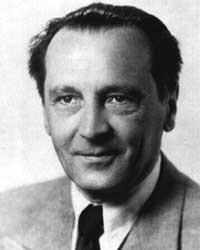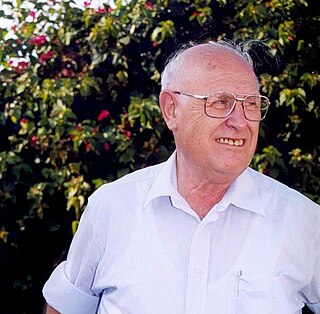
SLAC National Accelerator Laboratory, originally named the Stanford Linear Accelerator Center, is a federally funded research and development center in Menlo Park, California, United States. Founded in 1962, the laboratory is now sponsored by the United States Department of Energy and administrated by Stanford University. It is the site of the Stanford Linear Accelerator, a 3.2 kilometer (2-mile) linear accelerator constructed in 1966 that could accelerate electrons to energies of 50 GeV.

Mass spectrometry (MS) is an analytical technique that is used to measure the mass-to-charge ratio of ions. The results are presented as a mass spectrum, a plot of intensity as a function of the mass-to-charge ratio. Mass spectrometry is used in many different fields and is applied to pure samples as well as complex mixtures.

Accelerator mass spectrometry (AMS) is a form of mass spectrometry that accelerates ions to extraordinarily high kinetic energies before mass analysis. The special strength of AMS among the different methods of mass spectrometry is its ability to separate a rare isotope from an abundant neighboring mass. The method suppresses molecular isobars completely and in many cases can also separate atomic isobars. This makes possible the detection of naturally occurring, long-lived radio-isotopes such as 10Be, 36Cl, 26Al and 14C.

In experimental physics, a quadrupole ion trap or paul trap is a type of ion trap that uses dynamic electric fields to trap charged particles. They are also called radio frequency (RF) traps or Paul traps in honor of Wolfgang Paul, who invented the device and shared the Nobel Prize in Physics in 1989 for this work. It is used as a component of a mass spectrometer or a trapped ion quantum computer.
Microdosing, or micro-dosing, involves the administration of sub-therapeutic doses of drugs to study their effects in humans, aiming to gather preliminary data on safety, pharmacokinetics, and potential therapeutic benefits without producing significant physiological effects. This is called a "Phase 0 study" and is usually conducted before clinical Phase I to predict whether a drug is viable for the next phase of testing. Human microdosing aims to reduce the resources spent on non-viable drugs and the amount of testing done on animals.

Isotope-ratio mass spectrometry (IRMS) is a specialization of mass spectrometry, in which mass spectrometric methods are used to measure the relative abundance of isotopes in a given sample.

Institute of Physics, Bhubaneswar is an autonomous research institution of the Department of Atomic Energy (DAE), Government of India. The institute was founded by Professor Bidhu Bhusan Das, who was Director of Public Instruction, Odisha, at that time. Das set up the institute in 1972, supported by the Government of Odisha under the patronage of Odisha's education minister Banamali Patnaik, and chose Dr. Trilochan Pradhan as its first director, when the Institute started theoretical research programs in the various branches of physics. Other notable physicists in the institute's early days included Prof. T. P. Das, of SUNY, Albany, New York, USA and Prof. Jagdish Mohanty of IIT Kanpur and Australian National University, Canberra. In 1981, the Institute moved to its present campus near Chandrasekharpur, Bhubaneswar. It was taken over by the Department of Atomic Energy, India on 25 March 1985 and started functioning as an autonomous body.

Josef Mattauch was a nuclear physicist and chemist. He was known for the development of the Mattauch-Herzog double-focusing mass spectrometer, for his work on the investigation of isotopic abundances using mass spectrometry, and the determination of atomic weights. Much of his career was spent at the Kaiser Wilhelm Institute for Chemistry.
Alexander Alexeyevich Makarov, is a Russian physicist who led the team that developed the Orbitrap, a type of mass spectrometer, and received the 2008 American Society for Mass Spectrometry Distinguished Contribution in Mass Spectrometry Award for this development. In November 2013 he was appointed to Professor by Special Appointment of High Resolution Mass Spectrometry at the Department of Chemistry and the Bijvoet Center for Biomolecular Research of Utrecht University in the Netherlands.
The Institute for Radium Research is an Austrian research institute associated with the Austrian Academy of Sciences, Vienna. The Institute's researchers won multiple Nobel Prizes. Due to the gradual change of interests, "nuclear physics" was added to the institute's name in 1956. Since 2004, it is called the Stefan-Meyer-Institute for subatomic physics.
Arizona Accelerator Mass Spectrometry Laboratory focuses on the study of cosmogenic isotopes, and in particular the study of radiocarbon, or Carbon-14. As a laboratory, part of its aim is to function as a research center, training center, and general community resource. Its stated mission is conducting original research in cosmogenic isotopes. The AMS laboratory was established in 1981 at the University of Arizona.
The Institute of Applied Physics, National Academy of Sciences of Ukraine, was established by the Decree of the Presidium of NAS Ukraine from 21.11.1991 No. 299 on the base of the Sumy branch of the Institute of Metallophysics to enlarge the fundamental and applied investigations in nuclear technology. The initiative belongs to Volodymyr Yu. Storizhko, the current director of the IAP NAS Ukraine, academician of NAS Ukraine and co-scholars from the National Scientific Center “Khar’kov Physical-Technical Institute”, NAS Ukraine. The idea of the first academic institute in Sumy region was industriously supported by B.Ye. Paton, the President of NAS Ukraine and V.G. Barjakhtar, the first Vice-President NAS Ukraine, academician of NAS Ukraine. The IAP NAS Ukraine is a part of the Department of Nuclear Physics and Power Engineering, NAS Ukraine.

Amnon Marinov was an Israeli physicist. He undertook research into nuclear structures, nuclear reactions, superheavy elements and long-lived nuclear isomers.
Walter Kutschera is an Austrian physicist.
Albert Edward "Ted" Litherland is a nuclear physicist, known for his pioneering work in accelerator mass spectroscopy (AMS).
The André E. Lalonde Accelerator Mass Spectrometry Laboratory is an accelerator mass spectrometry research facility at the University of Ottawa in Canada. It is currently the only facility of its type in Canada. It is named after former University of Ottawa Faculty of Science dean André E. Lalonde, who died of cancer in 2012.
Pavel P. Povinec is Professor of Physics at Faculty of Mathematics, Physics and Informatics of the Comenius University in Bratislava (Slovakia). Head of the Centre for Nuclear and Accelerator Technologies (CENTA)








